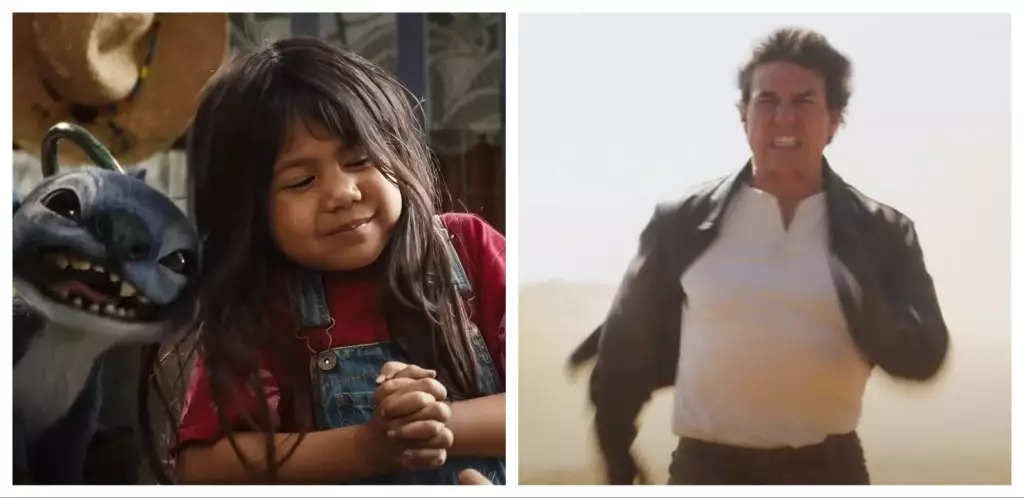As Hollywood reels from the staggering success of blockbusters like Disney’s *Lilo & Stitch* and Paramount’s *Mission: Impossible – The Final Reckoning*, one might be tempted to celebrate the resilience of the film industry. With reported international box office figures reaching impressive heights—$610.8 million for *Lilo & Stitch* and $353.8 million for *Mission: Impossible 8*—the narrative appears to flaunt a thriving cinematic renaissance. Yet, beneath this veneer of triumph lies an unsettling truth: the industry may be dancing on a delicate tightrope, precariously swaying between financial success and creative stagnation.
The initial allure of these films can hardly be denied. Audiences flocked to the theaters, buoyed by nostalgia and the magnetic presence of stars like Tom Cruise. However, with soaring revenues comes an equally insidious concern—the reliance on established franchises and nostalgic properties is overshadowing original storytelling. If the current trajectory continues, we may find ourselves in a quagmire where creativity and risk-taking are sacrificed at the altar of guaranteed returns.
The Franchise Factory: A Double-Edged Sword
Both *Lilo & Stitch* and *Mission: Impossible 8* exemplify a broader trend where studios have turned to superhero sagas, sequels, and rebooted classics as their bread and butter. While the financial results may be undeniably appealing, one must question whether this approach serves the greater good of artistic expression. By banking on beloved properties—often at the expense of new narratives—the industry risks alienating audiences in the long run.
In the race for box office supremacy, the industry appears to be echoing a mantra: “If it ain’t broke, don’t fix it.” This strategy has worked with films that have established character arcs and built-in fan bases. However, it stifles the influx of innovative perspectives that can only emerge from original storytelling. With the international success of *Lilo & Stitch*, currently the highest-grossing Disney live-action film in Latin America, it becomes starkly evident that studios are choosing safety over originality.
Global Market Dynamics: A Mirage of Unity
While the international box office numbers are certainly impressive, they also highlight a disconcerting aspect of global market dynamics. The figures suggest a universal acceptance of these films, but they mask a deeper fragmentation in audience preferences and cultural receptivity. The film industry is often quick to claim that box office success signals a universal appeal, yet regional nuances remain poorly addressed.
In countries like Japan and Brazil, *Mission: Impossible 8* made significant strides. Still, such successes do not negate the fact that the market is not a monolith. The film’s reception varied markedly across territories, illustrating the complexity of audience taste. Furthermore, the rising dominance of Hollywood titles in these markets often comes at the expense of local narratives that reflect regional identities. As blockbusters crowd out local filmmaking efforts, cultural diversity—even in a globalized world—faces severe threats.
The Social Media Age: The New Litmus Test
Another dimension to consider is the role of social media in shaping box office outcomes. Films like *Final Destination Bloodlines* and its recent success illustrate a shift where audience engagement on social platforms acts as a significant litmus test for a film’s success. The likes, shares, and social scores are no longer mere barometers; they can make or break a film’s trajectory within the first few days of its release. While this is undoubtedly a modern boon, it also raises concerns about the commodification of artistic value reducing creative endeavors to mere numbers.
Film critics and enthusiasts often lament the influences of algorithms and viral trends on audience choices, fearing that genuine artistic merit becomes overshadowed by the fickle whims of social media. The landscape is rapidly changing, and the very essence of cinematic storytelling is being recalibrated to fit within the scrolling feeds and soundbites of digital platforms.
A Call for Balanced Growth
As we celebrate the financial triumphs of mega-hits, we must not shy away from a critical dialogue surrounding the health of the industry. The phenomenal holds and overwhelming commercial success of prominent franchises come with the inherent risk of stagnation in creativity and cultural representation. An over-reliance on familiar properties means we are, inevitably, stifling a potential treasure trove of new stories and ideas.
As audience attention wanes and tastes evolve, Hollywood must pivot towards nurturing fresh talent and original narratives while maintaining a balance with safe bets. Only then can we aspire to create a vibrant, resilient cinematic future—one that honors its past while setting the stage for innovation.


Leave a Reply